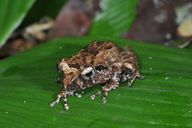|
Pseudophilautus limbus (Manamendra-Arachchi & Pethiyagoda, 2005)
| family: Rhacophoridae subfamily: Rhacophorinae genus: Pseudophilautus |
| Species Description: Manamendra-Arachchi K & Pethiyagoda R 2005 The Sri Lankan shrub-frogs of the genus Philautus Gistel, 1848 (Ranidae:Rhacophorinae), with description of 27 new species. Raffles Bull Zool Suppl. 12:163-303. | |
 © 2012 Dr. Peter Janzen (1 of 7) |
|
|
|
Description This is a moderate-sized frog with snout vent length of 22.9 - 25.6mm in males and 29.3 – 30.7mm in females. Tympanum discernible. Dorsal surface of body glandular, with prominent warts. Supratympanic fold prominent. Canthal edges more or less straight. Skin on head co-ossified with cranium. Nuptial pads absent. Median lingual process present, small and conical. Tarsal tubercle present. Supernumerary tubercles present on manus and pes. Toes medially webbed. Chest and belly heavily granular. Large, dark brown more or less square-shaped blotch on middorsum between forelimbs. Anterior and posterior surfaces of thigh and posterior flank region with black and white patches (Batuwita, Silva and Udugampala 2019). Colour in life: Dorsum light brown with dark brown patches. Middle of tympanum dark brown, border lighter. Upper lip dark brown with pale and ashy brown patches. Loreal region dark brown. Anterior mid dorsal region of the body with a large, dark brown, square-shaped patch. Upper flank light brown to chestnut; lower flank spotted in females. Dorsal and lateral regions of forelimb and dorsal region of thigh, shank, and pes brown with dark brown crossbars. Throat, chest, belly, and underside of thigh light yellow with small dusky spots, throat light yellow in males. Webbing dark brown (Batuwita, Silva and Udugampala 2019). Colour in alcohol: Dorsum greyish with dark grey-brown patches. Anterior mid-region of the body with a large, dusky, square-shaped patch. The region below supratympanic fold dusky brown than that above, tympanum dusky brown than the area surrounding it, lower margin of tympanum whitish. Loreal region greyish. Anterior flank greyish; posterior flank, anterior, and posterior thigh marbled in black and white. Dorsal and lateral sides of forelimb, dorsal side of thigh, dorsal side of shank, and dorsal side of pes brown with dark brown crossbars. Throat pale white with dark brown pigments; margins of lower jaw, anterior chest, belly, and underside of thigh pale white with dark brown pigments. Webbing black with small grayish patches (Batuwita, Silva and Udugampala 2019). Distribution and Habitat Country distribution from AmphibiaWeb's database: Sri Lanka
These frogs are most observed on the leaves of bamboo Davidsea attenuata vegetation. They have been observed calling from leaves and bamboo branches less than 1m above the ground. (Batuwita, Silva and Udugampala 2019). Larva Comments Pseudophilautus conniffae was previously confused with P. rus and differs from the latter by the combination of the following characters: fourth toe webbing to penultimate subarticular tubercle on inner and outer sides (vs. fourth toe webbing in between penultimate and anetpenultimate subarticular tubercles on inner and outer sides), presence of conical median lingual process (vs. absent), and black patches on the posterior flank, anterior and posterior edges of the thigh (vs. black patches on the anterior surface of the thigh) (Batuwita, Silva and Udugampala 2019). They are also found in different zoogeographic zones (lowland wet zone and Central respectively) further confirming they are two discrete species based on the geography as well (Batuwita, Silva and Udugampala 2019). Originally submitted by: Dayupathi Eranda Nipunika Mandawala (2023-04-11) Description by: Dayupathi Eranda Nipunika Mandawala (updated 2023-04-11)
Distribution by: Dayupathi Eranda Nipunika Mandawala (updated 2023-04-11)
Larva by: Dayupathi Eranda Nipunika Mandawala (updated 2023-04-11)
Comments by: Dayupathi Eranda Nipunika Mandawala, Michelle S. Koo (updated 2023-04-11)
Edited by: Michelle S. Koo (2023-04-11) Species Account Citation: AmphibiaWeb 2023 Pseudophilautus limbus <https://amphibiaweb.org/species/6490> University of California, Berkeley, CA, USA. Accessed Nov 22, 2024.
Feedback or comments about this page.
Citation: AmphibiaWeb. 2024. <https://amphibiaweb.org> University of California, Berkeley, CA, USA. Accessed 22 Nov 2024. AmphibiaWeb's policy on data use. |



 Map of Life
Map of Life